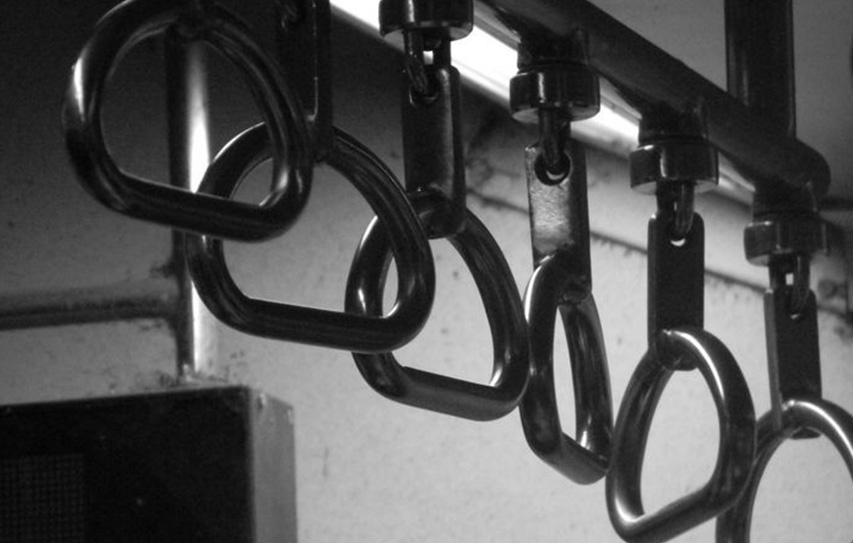
Small concerns: The Local train
by Deepa Bhalerao January 31 2014, 1:15 pm Estimated Reading Time: 4 mins, 57 secsThere local train platform is filled with people as I reach it around 8.30 am every day. Carrying laptops, handbags and lunchboxes, everyone is set for the day. Newspaper and food vendors are seen wandering around. The day begins really early in Mumbai. People travel from all ends of the city towards the workplaces which are concentrated in certain central locations. Trains are the dynamic arteries of the city. They transport thousands of people to and from work every single day and are rarely delayed or stalled.
As a train arrives, there is realigning of the groups and an inevitable scramble to alight. Within seconds, the train leaves the platform, and in the crowd inside shifts to adjust itself for the next stop.
In a journey that is undertaken standing, there is a lot to keep one visually alert. The general compartments are spilling over with people, and the first-class compartment is no different. These days, most travelers are glued to their cell-phones, listening to music or speaking or chatting or perhaps playing games. Some groups are singing and there are the usual chatterboxes relating their anxieties and concerns, and exchanging sympathies.
In this colorful atmosphere, there are certain actors who blend into the scene effortlessly, so much so that the regular travelers almost do not notice them. A group of gaudily made-up transvestites loom in and out of stations, attracting attention by their loud voices and overt demands for money as also their benevolently sprinkled blessings. The singing beggar couples make their rounds occasionally and elicit sympathetic gestures from the passengers. And then, there are the vendors- men and women, selling trinkets (hairclips and earrings), and objects for everyday use (plastic wallets and hot water bottles, handkerchiefs and stationery)
One section of them stands out though- these are the children.
There are children who alight and leave in little groups, holding on to each other protectively, children who are selling things, laden with trays that are heavy and tough to carry through the crowds, children who come in with a broom, sweeping the compartment and asking for money in return, and children who just accompany their mothers who sell things or beg in the compartment.
Identifying these children is easy. They look tired and scruffy, undernourished, and obviously tiny for their age. They speak very little and almost never respond to any personal question. Those selling things are seen struggling to cart their goods to as many customers as possible, and often fumbling in the simple addition of the items sold.
I have tried to strike a conversation with some of them. They do respond when the queries are not of a probing nature or trying to establish some fact. But they seem wary of adults and speak in low tones, often cowering at a seemingly stern look that may not even be directed at them. They almost never look one in the eye and are ready to rush away at the slightest sign of disapproval.
I have often wondered where they come from and what kind of life they lead. What is the reason that compels them to spend their days on local train platforms, selling or begging or just wandering around? Who are the adults that are supposed to be taking care of them, and most importantly, why are the thousands of adults from the economically and socially better-off strata not moved by their plight?
Twenty years ago, I used to feel that street-living children (as a lot of these are likely to be) are a problem peculiar to Mumbai where a lot of poor families migrate for work. But actual observations and statistics show that children who are homeless, or on the fringes of society, for myriad reasons, are a reality in almost all urban centers including smaller cities.
It is impossible to not notice them around you. On busy roads they come to sell flowers at traffic lights, near temples they come to beg, on street corners, they can be found playing in the dust, and sometimes just wandering around looking at shop-windows in a sense of wonder.
What is also difficult to ignore is that how they are just accepted as part of the urban landscape and perhaps not even noticed as an aberration in the scene. Children, no matter which family they are born into, have a right to food, shelter and education. They are not supposed to be working for a living let aside begging for one. No child chooses to be in such an environment and is not responsible for the situations they are thrust into by careless adults, even if they are his/her parents.
We live in an age of innovation and wonder. We have the world looking at us as an emerging superpower, we hold our own identity in the league of international movers and shakers, and we take immense pride in our unique culture and heritage. Yet, what progress and what transformation are we imagining if as a society we are oblivious of the most basic of our domestic issues? A strong and capable society is one which does not ignore the basic needs of its weakest component.
It is true that there are many social organizations dedicated to addressing the concerns of children in underprivileged situations, and that they are doing commendable work, but it is also true that they have their hands full and are unable to reach out to many thousands yet. Work is going on but it is not enough yet. There is a serious need for realizing that many hands are required to hold a child through the vulnerable wonder years.
I look forward to the day when civil rights dialogues on the various forums include the most basic of human rights- the rights of the child to whom we owe the dignity of a childhood, which is often the only template that most of us have for what we call happiness.




-173X130.jpg)
-173X130.jpg)
-173X130.jpg)

-173X130.jpg)
-173X130.jpg)
-173X130.jpg)
-173X130.jpg)